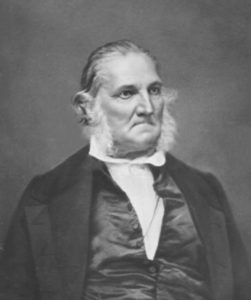We usually think of the artist-ornithologist John James Audubon, gun on shoulder or pen in hand, as a man with his eyes on the sky. Audubon, after all, was the special chronicler of North American birds. But from time to time, Audubon looked at the ground. Like many naturalists of his generation, he raided burials or picked up human skulls he found. He then sent them to Dr. Samuel George Morton, the Philadelphia craniologist we remember as the father of “scientific racism,” the idea that cranial capacity mirrored racial hierarchy.
Our recent racial reckoning and the harassment of Black birder Christian Cooper in New York’s Central Park took me back to Audubon’s contribution to Morton’s skull collection. Audubon sent Morton five skulls from Texas—the heads of four Mexican soldiers and one “Hispano-Indian,” bullet-riddled and left unburied in the aftermath of the Battle of San Jacinto.

Figure 1: J.J. Audubon in Later Years. Fredricks, Charles DeForest, 1823-1894 Photographer, Public domain, via Wikimedia Commons.
In 1843, Audubon set out on a last adventure, traveling up the Missouri River and out the Yellowstone. He felt his age, turning 58 that spring. (Figure 1) A year earlier, he had settled his family into “Minniesland,” his country estate in northern Manhattan. With his great work on Birds of America behind him, Audubon was anxious for a last chance to see the creatures of the American west and to collect specimens for a catalogue of the Quadrupeds of North America. He described squirrels, rats, porcupines, beavers, wolves, and buffalo and visited the Mandan and Assiniboine villages devastated by the smallpox epidemics that swept the northern plains in the 1830s. And Audubon sent Morton another five skulls. (Figures 2-4)
Morton and his skull measurements have long been part of the scholarship on American racism, but what happens when we draw Audubon into the racial drama? Should Audubon’s connection to Morton send a shiver through the history of this remarkably talented, complicated man?
By 1843, Audubon was famous, well known as an artist and naturalist. But he had never been a rich man, and his ambitious projects needed support. He counted on the forts and trading posts the U.S. government maintained in the West and on a network of naturalists who helped collect specimens and sell books. Morton, president of Philadelphia’s Academy of Natural Sciences, sustained Audubon’s connection to the scattered players in the world of American science.
Morton was a generation younger than Audubon, but the friendship between the two men ran back through the 1830s. Morton, with his institutional connections, helped assure Audubon a place in the country’s scientific establishment. He settled some of Audubon’s debts when the artist was in England and soothed his worries about upstart rivals. In return, Audubon looked for skulls for Morton. European craniologists weren’t ready to share their skulls with the Americans, although Audubon did find Morton a portfolio of sketches.